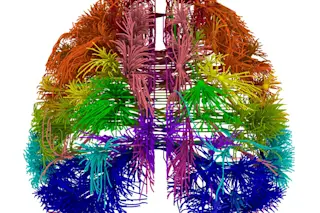A top-down 3-D view of the mouse connectome. Credit: Allen Institute for Brain Science The brain is an incredibly complex organ. The tiny mouse brain, for example, contains over 86 million neurons, each with over 1,000 different connections, clustered in different groupings. In a sense, the neural networks resemble a complex highway system between cities. To navigate the brain, researchers are going to need some maps, and two of the most detailed maps have just been created. Scientists from the Allen Institute for Brain Science in Seattle pored through massive data sets to build two new maps: one of gene expression in the developing human brain, and another of neural networks in a mouse brain. The maps, which are publicly available, will serve as resources for researchers around the world. Already, the data are revealing valuable insights about formation of autism and the way mammalian brains process information. Scientists shared ...
First Wiring Diagram of Mouse Brain Created
Explore the groundbreaking mouse connectome that reveals complex neural networks in the mouse brain, paving the way for autism research.
More on Discover
Stay Curious
SubscribeTo The Magazine
Save up to 40% off the cover price when you subscribe to Discover magazine.
Subscribe













